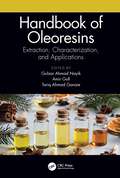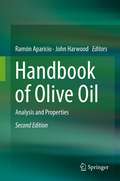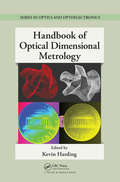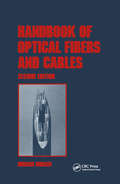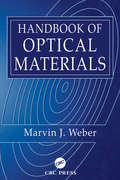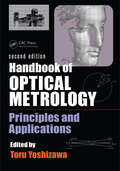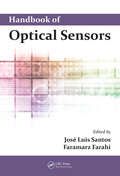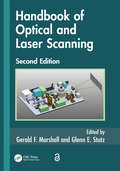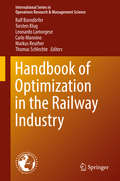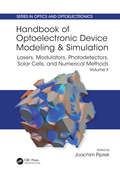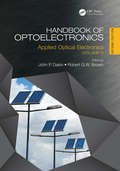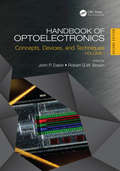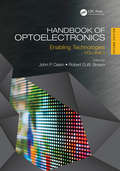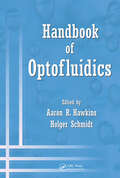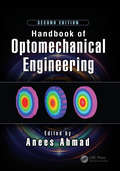- Table View
- List View
Handbook of Oil and Gas Piping: a Practical and Comprehensive Guide
by Murali Sambasivan Sekar GopalThe objective of this practical oil and gas piping handbook is to facilitate project management teams of oil and gas piping related construction projects to understand the key requirements of the discipline and to equip them with the necessary knowledge and protocol. It provides a comprehensive coverage on all the practical aspects of piping related material sourcing, fabrication essentials, welding related items, NDT activities, erection of pipes, pre-commissioning, commissioning, post-commissioning, project management and importance of ISO Management systems in oil and gas piping projects. This handbook assists contractors in ensuring the right understanding and application of protocols in the project. <P><P>One of the key assets of this handbook is that the technical information and the format provided are practically from real time oil and gas piping projects; hence, the application of this information is expected to enhance the credibility of the contractors in the eyes of the clients and to some extent, simplify the existing operations. Another important highlight is that it holistically covers the stages from the raw material to project completion to handover and beyond. This will help the oil and gas piping contractors to train their project management staff to follow the best practices in the oil and gas industry. Furthermore, this piping handbook provides an important indication of the important project-related factors (hard factors) and organizational-related factors (soft factors) to achieve the desired project performance dimensions, such as timely completion, cost control, acceptable quality, safe execution and financial performance. Lastly, the role of ISO management systems, such as ISO 9001, ISO 14001 and OHSAS 18001 in construction projects is widely known across the industry; however, oil and gas specific ISO quality management systems, such as ISO 29001, and project specific management systems, such as ISO 21500, are not widely known in the industry, which are explained in detail in this handbook for the benefit of the oil and gas construction organizations. <P><P>Features: <li>Covering the stages from the raw material to project completion, to handover and beyond <li>Providing practical guidelines to oil and gas piping contractors for training purposes and best practices in the oil and gas industry <li>Emphasizing project-related factors (hard factors) and organizational-related factors (soft factors) with a view to achieve the desired project performance <li>Highlighting the roles of ISO management systems in oil and gas projects.
Handbook of Oleoresins: Extraction, Characterization, and Applications
by Gulzar Ahmad NayikAn Oleoresin represents the true essence of spices enriched with volatile and non-volatile essential oil and resinous fractions. The oleoresin represents the wholesome flavor of the spice, a cumulative effect of the sensation of smell and taste. Therefore, it is designated as "true essence" of the spice and can replace spice powders in food products without altering the flavor profile. Our earth comprises a plethora of spices that have carved a niche in the global market in medicinal and health-related food products. These spices play a dual role as a food ingredient and a therapeutic agent preventing various diseases. This industry has acquired tremendous attention not only from consumers but also from scientific communities, and various food manufacturing organizations. Handbook of Oleoresins: Extraction, Characterization, and Applications is a snapshot of information on oleoresins—production, composition, properties, applications (medicinal & health properties), and more. It is designed to be a practical tool for the various professionals who develop and market spices and oleoresins Key Features: Contains comprehensive information on the major oleoresins of the world Dicusses the extraction and characterization of major spice oleoresins Covers the safety and toxicity of oleoresins Sheds light on relationship between oleoresins and health benefits The world is moving towards natural products. Spices lend color, taste, and flavor, and oleoresins are good source of antioxidants and have preservative as well as therapeutic power. Therefore it is important to understand and document the chemistry, characterization, properties and applications of oleoresins, as found in this handbook.
Handbook of Olive Oil
by John Harwood Ramón AparicioThe Handbook of Olive Oil presents an up-to-date view of all aspects of olive oil. It is written from an inter-disciplinary point of view and will be of use in research and development as well as in routine laboratory and process operations. This second edition includes new chapters devoted to genetic studies and agronomic aspects of new orchards and cultivars, which, in combination with the most recent biochemical studies and technological developments, explain the unique chemical composition of olive oil. The analytical aspects of the first edition are now described in six new chapters focused on the chemical compounds responsible for olive oil traceability and sensory perceptions (odor, color, and taste) utilizing chromatographic, spectroscopic, and in-tandem techniques. Nutritional and sensory aspects are the basis for the current success of virgin olive oil among consumers, and this new edition re-analyzes in two new chapters the role of lipids, in general, and olive oil, in particular, in nutrition and health. In addition, the methodologies developed for determining sensory quality, olive oil oxidation, and deep-frying are extensively described and discussed. The role of consumers in olive oil studies of marketing and acceptability is covered in a new chapter. This second edition has not ignored the fact that the popularity of olive oil has made it a preferred target for fraudsters. Deliberate mislabeling or mixtures containing less expensive edible oils are topics described in depth in two chapters devoted to traceability and adulteration. There is also a new chapter focused on the olive refining process, which is a relevant activity in the olive oil world, and another chapter displaying tables of chemical and sensory information from olive oils produced all over the world. The book is written at two levels: the main level is structured as a tutorial on the practical aspects of olive oil. A second, more methodological level, is intended for specialists in the different sciences that contribute to olive oil studies (biochemistry, chemistry, physics, statistics etc). This edition also details changes that are needed in different disciplines in order to overcome current problems and challenges.
Handbook of Online Learning
by Kjell Erik Rudestam Judith Schoenholtz-ReadThe Handbook of Online Learning is a comprehensive reference text for teachers and administrators of online courses and programs. It presents a discussion of the conceptual and theoretical foundations of online learning along with an exploration of practical implementation strategies. New and Ongoing FeaturesEmphasizes interactive teaching/learning strategies – challenging readers to think differently about pedagogy Provides a strong theoretical base before discussing applications: Part I first presents the changing philosophies and theories of learning, while Part II covers implementation or the practice of online learning Offers several chapters that deal with the issues related to the growing corporate online learning environment Includes twelve NEW articles on the latest issues such as psychology of online learning, training faculty, digital libraries, ethical dimensions in online learning, legal issues, course management systems and evolving technologies. key articles retained from current edition are revised and updated to reflect current trends and changes in the field Praise for the First Edition"The Fielding Institute authors apply an impressive wealth of organizational management theory and experience in their analyses of computer-mediated teaching and learning. The result is an enjoyable-to-read, fresh and lively book, delivering an abundance of ideas about how to establish a supportive learning environment, design a well structured course and manage electronically mediated dialog, -- in other words, how to successfully facilitate learning in the new context of on-line distance education."—Michael G. Moore, Pennsylvania State University and Editor, The American Journal of Distance Education "This book is a fascinating, comprehensive, revealing array of information about online learning. It is full of practical applications and significant implications for a future where online learning will play an increasingly larger role. It is essential for any library keeping up on online learning innovations." —Dr. Bernard J. Luskin, President and Co-CEO, GlobalLearningSystems, Inc. Visiting Professor, Claremont Graduate University"This book not only is that rare breed that addresses online learning in both higher education and corporate environments but every chapter is intriguing, informative, and accurately grounded. This book provides a comprehensive, timely, and informative look at online learning in higher education and corporate training settings. For an update on the state of e-learning in educational and training environments, simply read this book."—Curtis J. Bonk, Ph.D., Indiana University and Courseshare.com"Business and Learning have enjoyed a symbiotic relationship in our culture. The pace of change, however, has created separation between these two vital elements. The "Handbook of Online Learning" showcases the latest thinking and applications in learning delivery, and offers real promise that the gap is being bridged." —D.M. Verkest, AT&T Wireless Services, Vice-President-National Operations "The authors of this book are all experienced distance educators who know what the issues are: How are people engaged in teaching and learning at a distance "present" to one another? How do you create a community in the class? How can a teacher deal with an obstreperous student? What are the teaching/learning environments in universities and corporations as they affect distance education? The essays in this book inhabit the border where the idea of distance education meets the reality. The give practical advice and provide examples informed by both theory and experience."—Stanley Chodorow, Professor Emeritus, University of California, San Diego & Former CEO, California Virtual University
Handbook of Optical Dimensional Metrology (Series in Optics and Optoelectronics)
by Kevin HardingDue to their speed, data density, and versatility, optical metrology tools play important roles in today's high-speed industrial manufacturing applications. Handbook of Optical Dimensional Metrology provides useful background information and practical examples to help readers understand and effectively use state-of-the-art optical metrology methods
Handbook of Optical Engineering (Optical Science and Engineering)
by Daniel MalacaraThis handbook explains principles, processes, methods, and procedures of optical engineering in a concise and practical way. It emphasizes fundamental approaches and provides useful formulas and step-by-step worked-out examples to demonstrate applications and clarify calculation methods. The book covers refractive, reflective, and diffractive optical components; lens optical devices; modern fringe pattern analysis; optical metrology; Fourier optics and optical image processing; electro-optical and acousto-optical devices; spatial and spectral filters; optical fibers and accessories; optical fabrication; and more. It includes over 2,000 tables, flow charts, graphs, schematics, drawings, photographs, and mathematical expressions.
Handbook of Optical Fibers and Cables, Second Edition (Optical Science and Engineering #1)
by Hiroshi MurataThis work covers the history of optical communications, fibres and fiber cables, and compares optical fibres with other transmission media. It also discusses optical fibre materials, reliability and manufacture, illustrates the design, construction and properties of recent cables used for optical fibre, describes fibre splicing and presents automated fibre splicing machines, and more.
Handbook of Optical Interconnects (Optical Science and Engineering)
by Shigeru KawaiAs we reach the data transmission limits of copper wire and communications experts seek to bring the speed of long-haul fiber optics networks closer to access points, optical interconnects promise to provide efficient, high-speed data transmission for the next generation of networks and systems. They offer higher bit-rates, virtually no crosstalk, lower demands on power requirements and thermal management, and the possibility of two-dimensional channel arrays for chip-to-chip communication.The Handbook of Optical Interconnects introduces the systems and devices that will bring the speed and quality of optical transmission closer to the circuit board. Contributed by active experts, most from leading technology companies in the US and Japan, this outstanding handbook details various low-cost and small-size configurations, illustrates the discussion with more than 300 figures, and offers a look at the applications and future of this exciting and rapidly growing field. The book includes a detailed introduction to vertical cavity surface-emitting lasers (VCSELs); the use of optical interconnects in metropolitan, local-area, and access networks through FTTP (FTTH); and Jisso technologies, which are critical for developing low-cost, small-size modules.Driving down the size and cost of optical interconnects is vital for integrating these technologies into the network and onto microprocessors, and the Handbook of Optical Interconnects provides the knowledge and tools necessary to accomplish these goals.
Handbook of Optical Materials: Optical Materials (Laser & Optical Science & Technology #19)
by Marvin J. WeberFor years scientists turned to the CRC Handbook of Laser Science & Technology for reliable data on optical materials. Out of print for several years, that standard-setting work now has a successor: the Handbook of Optical Materials.This new handbook is an authoritative compilation of the physical properties of materials used in all types of lasers and optical systems. In it, scientist, author, and editor Dr. Marvin J. Weber provides extensive data tabulations and references for the most important optical materials, including crystals, glasses, polymers, metals, liquids, and gases. The properties detailed include both linear and nonlinear optical properties, mechanical properties, thermal properties together with many additional special properties, such as electro-, magneto-, and elasto-optic properties. Using a minimum of narration and logically organized by material properties, the handbook's unique presentation simplifies the process of comparing different materials for their suitability in particular applications. Appendices furnish a wealth of other useful information, including lists of the many abbreviations and acronyms that proliferate in this field. The Handbook of Optical Materials is simply the most complete one-stop source available for materials data essential to lasers and optical systems.
Handbook of Optical Metrology: Principles and Applications, Second Edition
by Toru YoshizawaHandbook of Optical Metrology: Principles and Applications begins by discussing key principles and techniques before exploring practical applications of optical metrology. Designed to provide beginners with an introduction to optical metrology without sacrificing academic rigor, this comprehensive text: Covers fundamentals of light sources, lenses, prisms, and mirrors, as well as optoelectronic sensors, optical devices, and optomechanical elements Addresses interferometry, holography, and speckle methods and applications Explains Moiré metrology and the optical heterodyne measurement method Delves into the specifics of diffraction, scattering, polarization, and near-field optics Considers applications for measuring length and size, displacement, straightness and parallelism, flatness, and three-dimensional shapes This new Second Edition is fully revised to reflect the latest developments. It also includes four new chapters—nearly 100 pages—on optical coherence tomography for industrial applications, interference microscopy for surface structure analysis, noncontact dimensional and profile metrology by video measurement, and optical metrology in manufacturing technology.
Handbook of Optical Sensors
by José Luís Santos Faramarz FarahiHandbook of Optical Sensors provides a comprehensive and integrated view of optical sensors, addressing the fundamentals, structures, technologies, applications, and future perspectives. Featuring chapters authored by recognized experts and major contributors to the field, this essential reference: Explains the basic aspects of optical sensors and
Handbook of Optical Wireless Communication
by Xizheng KeThe book focuses on optical wireless communication systems. It summarises the author's work on optical wireless communication during the implementation of relevant scientific research plans. The main contents include the research status and progress of optical wireless communication, including the author's own work in this field and the research progress of domestic and foreign scholars in related fields. The key technologies, key components, modulation and coding methods, influencing factors of coherent optical communication, underwater optical communication, visible light communication, and orbital angular momentum involved in wireless optical communication are analysed, and their research progress and development trends are presented. It is particularly suitable for readers interested in the field of wireless optical communications. This book can benefit researchers, engineers and graduate students in the field of telecommunications. Suitable for engineering and technical personnel involved in optical communications, university teachers, postgraduate students and advanced undergraduates.
Handbook of Optical and Laser Scanning (Optical Science and Engineering)
by Gerald F. Marshall Glenn E. StutzFrom its initial publication titled Laser Beam Scanning in 1985 to Handbook of Optical and Laser Scanning, now in its second edition, this reference has kept professionals and students at the forefront of optical scanning technology. Carefully and meticulously updated in each iteration, the book continues to be the most comprehensive scanning resource on the market. It examines the breadth and depth of subtopics in the field from a variety of perspectives. The Second Edition covers: Technologies such as piezoelectric devices Applications of laser scanning such as Ladar (laser radar) Underwater scanning and laser scanning in CTP As laser costs come down, and power and availability increase, the potential applications for laser scanning continue to increase. Bringing together the knowledge and experience of 26 authors from England, Japan and the United States, the book provides an excellent resource for understanding the principles of laser scanning. It illustrates the significance of scanning in society today and would help the user get started in developing system concepts using scanning. It can be used as an introduction to the field and as a reference for persons involved in any aspect of optical and laser beam scanning.
Handbook of Optimization in Complex Networks
by Panos M. Pardalos My T. ThaiComplex Social Networks is a newly emerging (hot) topic with applications in a variety of domains, such as communication networks, engineering networks, social networks, and biological networks. In the last decade, there has been an explosive growth of research on complex real-world networks, a theme that is becoming pervasive in many disciplines, ranging from mathematics and computer science to the social and biological sciences. Optimization of complex communication networks requires a deep understanding of the interplay between the dynamics of the physical network and the information dynamics within the network. Although there are a few books addressing social networks or complex networks, none of them has specially focused on the optimization perspective of studying these networks. This book provides the basic theory of complex networks with several new mathematical approaches and optimization techniques to design and analyze dynamic complex networks. A wide range of applications and optimization problems derived from research areas such as cellular and molecular chemistry, operations research, brain physiology, epidemiology, and ecology.
Handbook of Optimization in Electric Power Distribution Systems (Energy Systems)
by Panos M. Pardalos Steffen Rebennack Mariana Resener Sérgio HaffnerThis handbook gathers state-of-the-art research on optimization problems in power distribution systems, covering classical problems as well as the challenges introduced by distributed power generation and smart grid resources. It also presents recent models, solution techniques and computational tools to solve planning problems for power distribution systems and explains how to apply them in distributed and variable energy generation resources. As such, the book therefore is a valuable tool to leverage the expansion and operation planning of electricity distribution networks.
Handbook of Optimization in the Railway Industry (International Series in Operations Research & Management Science #268)
by Ralf Borndörfer Torsten Klug Leonardo Lamorgese Carlo Mannino Markus Reuther Thomas SchlechteThis book promotes the use of mathematical optimization and operations research methods in rail transportation. The editors assembled thirteen contributions from leading scholars to present a unified voice, standardize terminology, and assess the state-of-the-art.There are three main clusters of articles, corresponding to the classical stages of the planning process: strategic, tactical, and operational. These three clusters are further subdivided into five parts which correspond to the main phases of the railway network planning process: network assessment, capacity planning, timetabling, resource planning, and operational planning. Individual chapters cover:SimulationCapacity AssessmentNetwork DesignTrain RoutingRobust TimetablingEvent SchedulingTrack AllocationBlockingShuntingRolling StockCrew SchedulingDispatching Delay Propagation
Handbook of Optoelectronic Device Modeling and Simulation: Fundamentals, Materials, Nanostructures, LEDs, and Amplifiers, Vol. 1 (Series in Optics and Optoelectronics)
by Joachim PiprekOptoelectronic devices are now ubiquitous in our daily lives, from light emitting diodes (LEDs) in many household appliances to solar cells for energy. This handbook shows how we can probe the underlying and highly complex physical processes using modern mathematical models and numerical simulation for optoelectronic device design, analysis, and performance optimization. It reflects the wide availability of powerful computers and advanced commercial software, which have opened the door for non-specialists to perform sophisticated modeling and simulation tasks. The chapters comprise the know-how of more than a hundred experts from all over the world. The handbook is an ideal starting point for beginners but also gives experienced researchers the opportunity to renew and broaden their knowledge in this expanding field.
Handbook of Optoelectronic Device Modeling and Simulation: Lasers, Modulators, Photodetectors, Solar Cells, and Numerical Methods, Vol. 2 (Series in Optics and Optoelectronics)
by Joachim PiprekOptoelectronic devices are now ubiquitous in our daily lives, from light emitting diodes (LEDs) in many household appliances to solar cells for energy. This handbook shows how we can probe the underlying and highly complex physical processes using modern mathematical models and numerical simulation for optoelectronic device design, analysis, and performance optimization. It reflects the wide availability of powerful computers and advanced commercial software, which have opened the door for non-specialists to perform sophisticated modeling and simulation tasks. The chapters comprise the know-how of more than a hundred experts from all over the world. The handbook is an ideal starting point for beginners but also gives experienced researchers the opportunity to renew and broaden their knowledge in this expanding field.
Handbook of Optoelectronics: Applied Optical Electronics (Volume Three) (Series in Optics and Optoelectronics)
by John P. Dakin Robert G. BrownHandbook of Optoelectronics offers a self-contained reference from the basic science and light sources to devices and modern applications across the entire spectrum of disciplines utilizing optoelectronic technologies. This second edition gives a complete update of the original work with a focus on systems and applications.Volume I covers the details of optoelectronic devices and techniques including semiconductor lasers, optical detectors and receivers, optical fiber devices, modulators, amplifiers, integrated optics, LEDs, and engineered optical materials with brand new chapters on silicon photonics, nanophotonics, and graphene optoelectronics. Volume II addresses the underlying system technologies enabling state-of-the-art communications, imaging, displays, sensing, data processing, energy conversion, and actuation. Volume III is brand new to this edition, focusing on applications in infrastructure, transport, security, surveillance, environmental monitoring, military, industrial, oil and gas, energy generation and distribution, medicine, and free space. No other resource in the field comes close to its breadth and depth, with contributions from leading industrial and academic institutions around the world. Whether used as a reference, research tool, or broad-based introduction to the field, the Handbook offers everything you need to get started. John P. Dakin, PhD, is professor (emeritus) at the Optoelectronics Research Centre, University of Southampton, UK. Robert G. W. Brown, PhD, is chief executive officer of the American Institute of Physics and an adjunct full professor in the Beckman Laser Institute and Medical Clinic at the University of California, Irvine.
Handbook of Optoelectronics: Concepts, Devices, and Techniques (Volume One) (Series in Optics and Optoelectronics)
by Robert Brown John P. DakinHandbook of Optoelectronics offers a self-contained reference from the basic science and light sources to devices and modern applications across the entire spectrum of disciplines utilizing optoelectronic technologies. This second edition gives a complete update of the original work with a focus on systems and applications.Volume I covers the details of optoelectronic devices and techniques including semiconductor lasers, optical detectors and receivers, optical fiber devices, modulators, amplifiers, integrated optics, LEDs, and engineered optical materials with brand new chapters on silicon photonics, nanophotonics, and graphene optoelectronics. Volume II addresses the underlying system technologies enabling state-of-the-art communications, imaging, displays, sensing, data processing, energy conversion, and actuation. Volume III is brand new to this edition, focusing on applications in infrastructure, transport, security, surveillance, environmental monitoring, military, industrial, oil and gas, energy generation and distribution, medicine, and free space. No other resource in the field comes close to its breadth and depth, with contributions from leading industrial and academic institutions around the world. Whether used as a reference, research tool, or broad-based introduction to the field, the Handbook offers everything you need to get started. (The previous edition of this title was published as Handbook of Optoelectronics, 9780750306461.) John P. Dakin, PhD, is professor (emeritus) at the Optoelectronics Research Centre, University of Southampton, UK. Robert G. W. Brown, PhD, is chief executive officer of the American Institute of Physics and an adjunct full professor in the Beckman Laser Institute and Medical Clinic at the University of California, Irvine.
Handbook of Optoelectronics: Enabling Technologies (Volume Two) (Series in Optics and Optoelectronics)
by John P. Dakin Robert G. BrownHandbook of Optoelectronics offers a self-contained reference from the basic science and light sources to devices and modern applications across the entire spectrum of disciplines utilizing optoelectronic technologies. This second edition gives a complete update of the original work with a focus on systems and applications.Volume I covers the details of optoelectronic devices and techniques including semiconductor lasers, optical detectors and receivers, optical fiber devices, modulators, amplifiers, integrated optics, LEDs, and engineered optical materials with brand new chapters on silicon photonics, nanophotonics, and graphene optoelectronics. Volume II addresses the underlying system technologies enabling state-of-the-art communications, imaging, displays, sensing, data processing, energy conversion, and actuation. Volume III is brand new to this edition, focusing on applications in infrastructure, transport, security, surveillance, environmental monitoring, military, industrial, oil and gas, energy generation and distribution, medicine, and free space. No other resource in the field comes close to its breadth and depth, with contributions from leading industrial and academic institutions around the world. Whether used as a reference, research tool, or broad-based introduction to the field, the Handbook offers everything you need to get started. (The previous edition of this title was published as Handbook of Optoelectronics, 9780750306461.) John P. Dakin, PhD, is professor (emeritus) at the Optoelectronics Research Centre, University of Southampton, UK. Robert G. W. Brown, PhD, is chief executive officer of the American Institute of Physics and an adjunct full professor in the Beckman Laser Institute and Medical Clinic at the University of California, Irvine.
Handbook of Optofluidics
by Holger Schmidt Haron R. HawkinsOptofluidics is an emerging field that involves the use of fluids to modify optical properties and the use of optical devices to detect flowing media. Ultimately, its value is highly dependent on the successful integration of photonic integrated circuits with microfluidic or nanofluidic systems. Handbook of Optofluidics provides a snapshot of the s
Handbook of Optomechanical Engineering (Optical Sciences and Applications of Light)
by Anees AhmadThis comprehensive handbook covers all major aspects of optomechanical engineering - from conceptual design to fabrication and integration of complex optical systems. The practical information within is ideal for optical and optomechanical engineers and scientists involved in the design, development and integration of modern optical systems for commercial, space, and military applications. Charts, tables, figures, and photos augment this already impressive text. Fully revised, the new edition includes 4 new chapters: Plastic optics, Optomechanical tolerancing and error budgets, Analysis and design of flexures, and Optomechanical constraint equations.
Handbook of Orthopaedic Trauma Implantology
by Arindam Banerjee Peter Biberthaler Saseendar ShanmugasundaramThis reference work comprehensively covers essential orthopedic trauma implants and their application in both upper and lower limbs. It offers insights into the invention, advantages, and disadvantages of various implants, along with the rationale behind their current designs, biomechanics, and materials. Additionally, the book addresses fracture fixation and general considerations when comparing different subgroups of implants, such as nails versus plates or ORIF versus external fixation.The book is divided into several sections, such as upper and lower limbs, spine, and pelvis. It also includes unique sections dedicated to pediatric implants, implant removal, metallurgy and bone grafts. It is written and edited by experienced surgeons from around the world. This book fills the gap as currently, there are no specific reference books on this topic but only operative manuals and inventory lists of various commercial companies detailing their own products.This highly informative and meticulously presented book serves as both a practical and a theoretical guide for practicing orthopedic surgeons, scientists/researchers, academicians, students as well as orthopedic technicians and nurses.
Handbook of Oxidative Stress in Cancer: Mechanistic Aspects
by Sajal Chakraborti Bimal K. Ray Susanta RoychoudhuryThis comprehensive, up-to-date reference work compiles the scientific research on the relationship between various forms of cancer and reactive oxygen species (ROS). It is well known that ROS play a key role in the various steps leading to malignancy, this includes increase in DNA mutation rates. The book brings together exciting reviews, written by leading experts all over the world. The book is divided into four broad sections. Each section describes the role of oxidative stress and underlying mechanisms and pathways, at various stages of cancer, including its role in carcinogenesis, cancer progression and metastasis. Further, the book describes how the reactive oxygen species (ROS) modulate gene expression and signal transduction pathways in cancer. The book discusses the ways to interfere with the cancer progression, and design of anti-cancer drugs. The book provides an integrated approach for better understanding of the development phases of oxidative stress-induced cancers, and mainly the current perspectives about mechanistic aspects of cancer initiation, progression and metastasis. It is a highly resourceful book and would be extremely important to clinicians, students and researchers in the field of cancer genetics, therapeutics and oncology.

